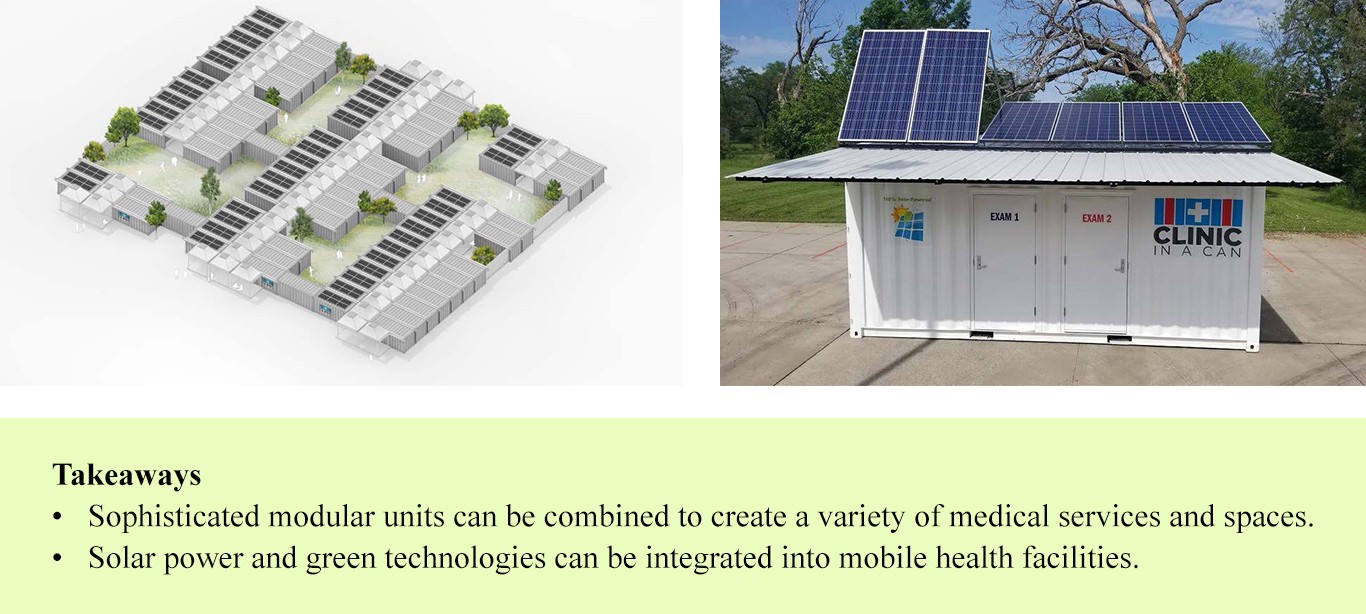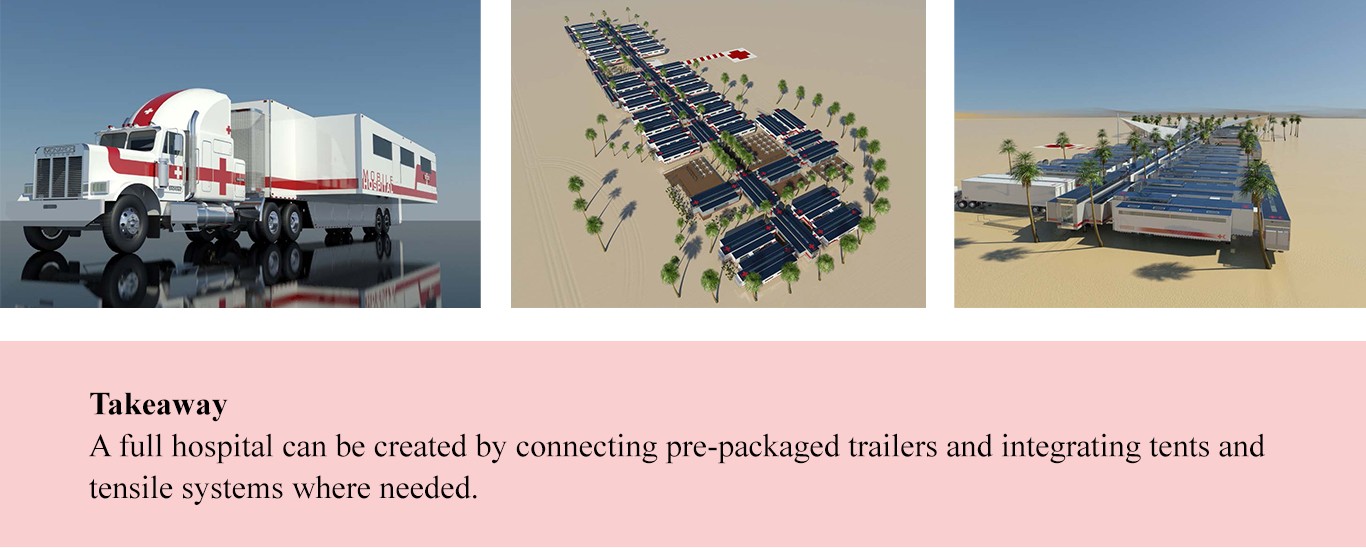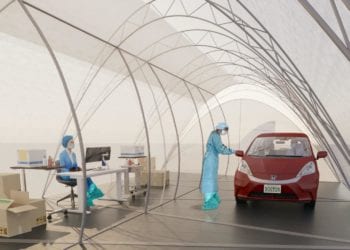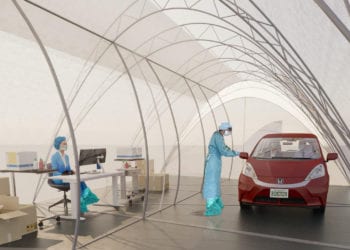Fighting COVID-19 is primarily a medical and public health challenge. However, the recent crisis in communities large and small highlights the need for temporary emergency shelters and structures to assist health professionals in their battle to overcome this virus.
This post explains the need and the opportunity for the design and engineering community to collaborate in developing new solutions to help fight these kinds of public health challenges, now and in the future. The post is authored by four members of the PLA team: Elizabeth Cornfeld, Tina Lee, Harper Smith, and Paul Lukez (see their bios below). As resources, they have compiled 12 examples of design systems and proposals for fighting emergency health crises such as the COVID-19 pandemic.
The COVID-19 pandemic has revealed the need to quickly mobilize the installation of temporary emergency structures that complement and reinforce existing medical facilities and hospitals and provide autonomous facilities where needed in more remote locations. To do this, designers, engineers, health professionals, corporations and government entities are developing innovative structural systems that often integrate new technologies and design techniques. The following 12 examples are organized around three concepts:
- Mobile Medical Facilities
- Rapid On-site Installations, using tensile and flat-pack technologies
- Conversions of Existing Facilities, such as convention centers and hotels
Mobile Medical Facilities
Mobile medical facilities are being constructed around the globe. These systems often use shipping containers, pneumatic structures, or hybrid systems. These mobile systems are often fully outfitted with all necessary medical systems. They are preconfigured to provide a range of medical services and support spaces as specific health challenges demand. People can rapidly deploy them by either plugging them into existing (hospital) infrastructure systems or operating them more autonomously.
Number #1: Carlo Ratti – Italian Architects Carlo Ratti and Italo Rota, along with Jacobs Engineering Studio and others, have designed an intensive-care pod, CURA, using shipping containers linked to one another with pneumatic structures. These pods can be added to hospitals fighting the coronavirus or deployed autonomously. They are designed for rapid deployment in cities worldwide, in immediate response to the dearth of intensive care units (ICU) in hospitals and the proliferation of the virus.
The construction of the CURA units in recycled shipping containers 6.1 meters in length allows them ample space for a sophisticated ventilation system that produces negative pressure within, which labs and hospitals often do to block the escape of contaminated air. Each of the units will also contain additional medical equipment needed to support patients. For more information, see: https://bit.ly/39WuMSc
Number 2: STAAT Mod – Responding to the current COVID-19 crisis with lighting speed, HGA designed in one week a rapidly deployable health facilities system, STAAT Mod (Strategic Temporary Acuity Adaptable Treatment Module), built by HGA’s partner Boldt.
STAAT Mod can be configured to house a variety of programs and different sites, including existing hospital facilities and their parking lots. The system comes in different configurations, including a two-room isolation unit, ideal for use in convention centers. Another configuration is based on an eight-bed unit, including critical care isolation rooms. These modules can be connected to an existing hospital.
A third configuration type, a 12-bed unit of open bays retrofit with ventilation systems producing negative pressure, comprises four three-bed open-bay modules linked to a central support spine in a way that allows addition of as many self-sustaining tiers as needed. Multiple units can also be connected together to allow for a larger capacity.
One advantage of STAAT Mod is that it meets CDC guidelines to provide immediate critical care to coronavirus patients. See: https://bit.ly/3b2HXm2
Number 3: Clinic in a Can – Clinic in a Can is a company that creates mobile medical clinics from shipping containers, as well as tent structures if needed. Shipping-container units are designed to provide a variety of uses (ICUs, surgical and support spaces, etc.), often combining the modular units. These clinics can also be solar-powered. They have been deployed in developed and developing countries worldwide. For virtual tours of these mobile clinics, see: http://www.clinicinacan.org/about
Number 4: Health Box – Biennale Architettura 2016 – Health Box was exhibited at Biennale Architettura 2016 as part of the Italian Pavilion. The proposal calls for deployable “devices” that provide essential services related to health and other societal needs. Each device is towable, using conventional “holiday trailers” as a platform.
Number 5: Hospitainer – Hospitainer, a Dutch company, specializes in rapid medical facilities that has a large range of uses and can be shipped anywhere. These structures can be used on the ground, on the water (shallow rivers and canals), or on wheels. This company has different tent-oriented and containerized solutions for X-rays, pharmacies, surgery, quarantining and other uses. Individual units can be configured in a variety of formats and scales, from smaller to larger mobile hospital facilities. See: https://hospitainer.com
Number 6: Mobile Hospital / Hord Coplan Macht + Spevco – Hord Coplan Macht + Spevco has designed a new type of hospital that is based on trucking prepackaged and deployable medical facility units such as operating rooms, ICUs, mobile pharmacies, etc. Designed as a comprehensive 58,000 SF (5,800 SM) 48-bed hospital facility, this 58-trailer system can create ground-up hospitals within two weeks, even in more remote sites facing health crises. See: https://bit.ly/2RtPR06












